
|

|
|
Home Site Search Contact Us Subscribe
|
|
|
Twilight Visions: Vintage Surrealist Photography Sheds New Light on Architecture An exhibition and book of photographs of Paris between the wars might just be the necessary correctives to the virtual sterility of digital imagery By Norman Weinstein February 9, 2010 One level of architectural photography certainly went to the grave when the Promethean genius Julius Shulman died last year, this in spite of the fact that I was cheering him to live another decade. Now I’ll have to transfer my Methuselah-wishes to Oscar Niemeyer.
Schulman was considerably more than one of architecture’s greatest photographers to date. He photographed a zeitgeist, the mind-set of California Modernism at its most sensually ripe. Before and after him, talented architectural photographers have come and gone, content to photograph what was on the site, with various forays hinting at more than surface imagery. Schulman photographed atmospheres of an era’s mind-set, and, as has often been noted, put the Beautiful People of his California dream front and center as something more than furniture.
In the 21st century, we have the wonder of high-tech. Now, software can superimpose on existing photographs of architecture any kind of disembodied ghosts we wish. Or am I thinking about those ghastly ghostly apparitions that inhabit eerily the video monitors of BIM users?
With Schulman and his California dreaming behind us, what can be hoped for architectural photography? The trick now may be finding new ways to integrate humans in architectural photography, reminding us that, yes, we still design for real live ones, shifty clients with shifty visions. Curious this need arises in ever greater urgency as architectural practice, when not literally tottering on the edge of bankruptcy, may risk intellectual bankruptcy in a high-stakes poker stand-off between Clean Green primacies and The-One-With-the-Best-Tech-Toys wins.
Through May 9th, there’s a photography exhibit at New York’s International Center of Photography, “Twilight Visions: Surrealism, Photography, and Paris.” It moves to the Telfair Museum of Art in Savannah, Georgia, in June. But if you’re unable to see it in either venue, The University of California Press has published an exquisite exhibition catalogue, Twilight Visions: Surrealism and Paris, by Therese Lichtenstein. The U.K. art critic Julia Kelly contributes this thought to the book: “Surrealism brings to mind a series of evocative and shifting locations – Parisian streets, outmoded parks and arcades, subway entrances, and deserted town squares – marking out a special, trancelike urban wandering.”
Take that idea of urban photography evoking shifting locales marking out an observer’s wandering – and then meditate on the eight photographs comprising the series Nuits parisiennes (Paris Nights) by the French photographer Brassai. This is an architectural photographic sequence of Paris that puts the observer into multiple narrative paths simultaneously, making the shifty architectural observer shiftier than ever. There’s heavy theatrical shadow-play dappling the images, since the razor-sharp definitions of modern color photography weren’t invented in circa 1930s. But just as surely as Alfred Hitchcock’s cinematography revealed the vertiginous atmosphere of built San Francisco, so Brassai and many of the other French photographers showcased in this exhibit and catalogue make us keen wandering, wondering, ever shifting, observers of urban architecture.
How can this apply to a single design project? How might a client react to the juxtaposition of BIM imagery with self-consciously surreal photography of a parallel project? One image is technically crisp. The other is expressionistic drama, though a drama of the miraculous everyday. Both embody different and shifting storytelling techniques. The computer graphics storyline is a linear, purposeful walk-through. The surreal photographic sequence is non-linear, loopy, non-resolved. This is how we live – in both styles of moving through architecture.
Surrealism stopped being an art movement by 1945. It is no longer a cult style. It is one of many popular ways of life globally. To embrace the surrealistic potential of architectural photography is to embrace the client as a wondering wanderer, confusing her or his body’s shadows with those of buildings, quintessentially not in noon sun, but at twilight, when dream and waking aspirations for design fuse.
Norman Weinstein writes about architecture and design for Architectural Record and The Christian Science Monitor, and is the author of “Words That Build” – an exclusive 21-part series published by ArchNewsNow.com – that focuses on the overlooked foundations of architecture: oral and written communication. He consults with architects and engineers interested in communicating more profitably. You can reach him at nweinste@mindspring.com.
More by Weinstein:
Op-Ed: Life After Ada: Reassessing the Utility of
Architectural Criticism
Best Architecture
Books of 2009
Book Review: "Gunnar Birkerts: Metaphoric Modernist" by Sven Birkerts and Martin Schwartz A major architect in the history of Modernism finally receives recognition – and sundry asides about why Modernism never exited.
Book Review:
"Urban Design for an Urban Century: Placemaking for People," by Lance
Jay Brown, David Dixon, and Oliver Gillham
Book Review:
"Everything Must Move: 15 Years at Rice School of Architecture 1994-2009"
Book Review: A Subversive Book Every Architect Needs:
"Architect's Essentials of Negotiation" by Ava J. Abramowitz
Book Review: A Perspective from One Elevation: "Conversations With Frank Gehry" by Barbara Isenberg Gehry's conversations offer portraits of an astute listener as well as talker, an architect as aware of his flaws and limitations as of his virtues.
Best Architecture Books of 2008
Book Review: You've Got to Draw the Line Somewhere A review of Drafting Culture: a Social History of Architectural Graphic Standards by George Barnett Johnston
Book Review: "NeoHooDoo: Art for a Forgotten Faith," edited by Franklin Sirmans Sharpen your pencils - and get ready to do a NeoHooDoo shimmy.
|
(click on pictures to enlarge) 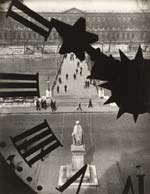 Courtesy International Center of Photography, New York, NY André Kertész: Clock of the Académie Française, Paris, 1932 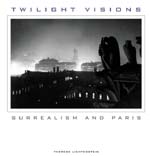 University of California Press “Twilight Visions: Surrealism and Paris” by Therese Lichtenstein includes 134 black & white photographs of Paris by Brassai, Andre Kertesz, Ilse Bing, Germaine Krull, and Man Ray, among others, and essays by Therese Lichtenstein, Julia Kelly, Colin Jones, and Whitney Chadwick. 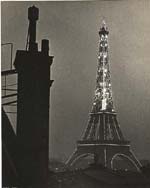 Courtesy International Center of Photography, New York, NY Ilse Bing: Eiffel Tower, 1934 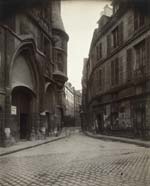 Courtesy International Center of Photography, New York, NY Eugène Atget: Rue du Figuier, 1924 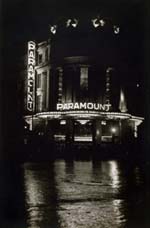 Courtesy International Center of Photography, New York, NY Germaine Krull: Le Cinéma Paramount, Paris, ca. 1930; |
© 2010 ArchNewsNow.com